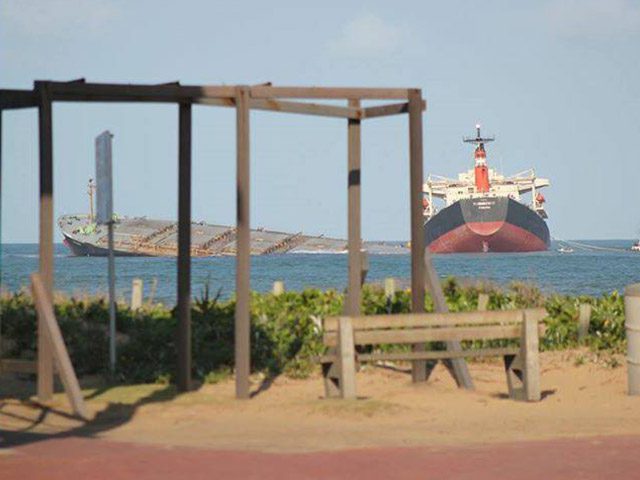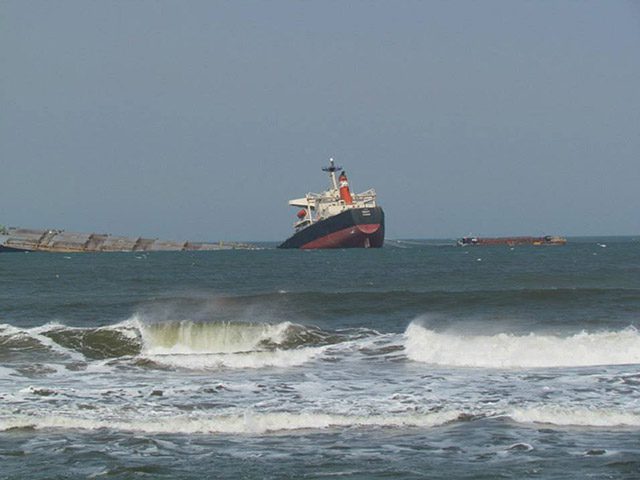Posted - By ET Bureau | 26 Aug, 2013, 10.47AM IST
With increase in number of maritime calamities, wreck and salvage
operations have become a regular activity in India. In an interview with
V Ayyappanof ETSL, Capt Sandeep Kalia, executive director of GOL
Salvage Services, the Great Offshore arm that has been engaged in many
such operations, sheds light on the issue of safety and security which
is no more limited to the country's maritime space.
Indian
waters is witnessing large number of marine calamities, especially on
the western front. What is your take on the reasons? The sea is perhaps the most difficult and vital
environment
in which man works. The natural perils of ocean transportation , the
inherent potential for human element and other factors mean that the
total eradication of shipping accidents is an impossibility. While
serious accidents are now far fewer in number, shipping casualties
continue to occur.
Lack of coordination between various
agencies / authorities , compliance with national & international
rules, improper communication and signals, complacency, attitudinal
& behavioral changes have all contributed to increase in the
causalities and the severance .
This does not mean that
Maritime causalities do not occur on the East coast or elsewhere. The
problem is that incidents occurring in the East coast are not
effectively highlighted or communicated or projected by the media.
While the maritime technology has changed beyond recognition between
1912 and 2012, the human factors and the executive factors have not.
This is a reflection of the largely physical nature of seafaring, as it
existed before the dawn of industrialization . As human innovativeness
has steadily found its way into shipping, skills required has evolved
from being purely physical to being increasingly intellectual in nature.
Accidents do occur and will continue to occur. They happen for
the same underlying human reasons, despite the technological
advancement in the last century and despite all safety regulations and
precautions.
It is even more remarkable to note that the
accident investigations and the reactions to accidents more or less are
the same now as they were 100 years ago. Another reason for
underestimating risks may be over reliance on new technology . The
industry only reacts to regulations when incidents and accidents occur,
with minimum compliance attitude. There is next to none pro-activeness
witnessed .
P & I Clubs have been found shirking
from responsibility in cases associated with many ship wrecks and
mishaps in the country. How could they manage to escape so easily?
One of the key challenges is the way in which the various national and
international regulatory frameworks and environmental considerations
come to bear on salvage and wreck removal.
As per relevant
portions of Merchant Shipping Act, 1958 and in the Indian Ports Act,
1908, ship owners are legally liable to remove the wreck only within the
territorial waters, if the wreck is a hazard in a shipping lane or
close to a navigation channel. Though Sections 10, 11, 12 and 14 of the
Indian Ports Act, 1908 would be relevant while discussing maritime
wrecks, the area of applicability of relevant sections is limited to the
'Port' or 'Limits of the Port' , hence, the said Act cannot be
effectively used to deal with wrecks beyond the port limits.
Recent events have however shown that the most of the wrecks actually
exist or shipping casualties occur, within the maritime zones of India
outside the limits of the ports, an area wherein the provisions of the
Indian Merchant Shipping or Ports Act, are not applicable.
Due to absence of binding legislation, owners and their clubs are not obliged to remove these wrecks.
With over 450 abandoned ship wrecks lying across Indian ocean
/coastal bed, can we ever have a safer ocean and safer shipping, as
mandated by IMO? Do you have any practical and cost effective way to
suggest to manage such a gigantic problem? There are
more than 450* abandoned wrecks along the coast. A high proportion of
the wrecks are in poor condition and pose an immediate threat to our
ecological systems.
India has acceded The Wreck Removal
Convention, which was adopted in May 2007, extends the powers of coastal
states to take action to remove wrecks posing hazards in the Exclusive
Economic Zone, it will come into force only one year after 10 IMO member
states have ratified it. Till then we have no control over the wreck
which are abandoned in our waters. So far a total of 6 member states
have ratified it.
The delay in decision making / finalization
of a salvage contract and finally responding to an emergency situation
by the Ship owners, authorities, administration individually or
collectively, turns the salvageable scenario into a wreck. Time is of
essence & every second counts.
Concern is also expressed on adequate
funding
methods that are not in place to cover an effective salvage response.
The response to any maritime causality would involve many government
agencies and organizations at the central, state and local levels. The
oil or the wrecks, if it is to be removed, needs to be funded by local
governments. A number of funding options could be explored, including
expansion of existing systems or development of new ones patterned after
successful funding mechanisms that needs to be in place.
Does Indian government encourage the Indian players?
It saddens me to submit that so far there has not been enough efforts,
encouragement or reforms by the GoI to promote or support Indian
players. Lack of recognition of national competence is purely driven by
ignorance . This has to change.
There is an imperative need to
reform our cabotage law and promote capacity building. The maritime
administration needs to set out exemplary standards to promote Indian
Salvors, by safeguarding their interests. There is enough talent &
capacity in the country to be self sufficient!!
The age old
mantra to fall back on already tried out & tested companies of
international repute, even at exorbitant cost & time delays is still
being practiced , thereby depriving the aspiring companies of
equivalent potential from within the country . There is no dearth of
talent, skills and professionalism in Indian Nationals.
Having
said that, the current team headed by the shipping minister, shipping
secretary & the director general of shipping looks promising.
Reportedly,
India witnessed over 81 oil spills in the last 30 years. What are the
impediments you find that make the country not yet ready for oil spills?
Based on your experience , what India requires now to maintain adequate
readiness? India's long shoreline is at risk of a
serious ecological disaster from such accidents & resulting oil
spills. The structural changes in the Indian oil sector and the advent
of NELP has led to large increase in oil exploration and exploitation of
Indian seas.
There is a persistent threat to Indian waters
particularly on the west coast which may create manmade oil spills. Any
such activity may create a catastrophic situation.
With the
increase in shipping causalities, the Indian law regarding salvage &
wreck requires a through revamp. The need for a comprehensive response
system has been flashed in various forums by agencies, authorities and
the government.
There is an imperative need for an "association
or body" in India which deals with all relevant aspects of oil spills,
including , need for review of different existing legislation and the
need for training and re-training. How well we resolve these issues in
coming years could, very well, determine just how productive the
maritime industry is for the generations of tomorrow.
How much is your company different from other international players and what is the edge that keeps it ahead?
GOL Salvage has access to a gamut of offshore assets. "GOSalvage" is
fortunate to have inherited a very experienced team from the GOL
Offshore group. Where we have reached today is due to excellent and
endless efforts of the team ashore and offshore .
We are also benefited from our team's understanding of local topographical
conditions vide our extensive operations. It is an edge which no other
national or international agency can claim.
Post can be found at:
http://economictimes.indiatimes.com/opinion/interviews/indias-long-shoreline-is-at-risk-of-serious-ecological-disaster/articleshow/22062216.cms




 ShareThis
ShareThis











